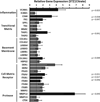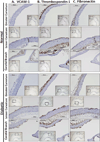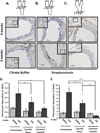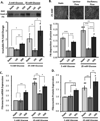Flow patterns regulate hyperglycemia-induced subendothelial matrix remodeling during early atherogenesis
- PMID: 24468139
- PMCID: PMC3905249
- DOI: 10.1016/j.atherosclerosis.2013.11.052
Flow patterns regulate hyperglycemia-induced subendothelial matrix remodeling during early atherogenesis
Abstract
Objective: Altered subendothelial matrix composition regulates endothelial dysfunction and early atherosclerotic plaque formation. Hyperglycemia promotes endothelial matrix remodeling associated with multiple microvascular complications of diabetes, but a role for altered matrix composition in diabetic atherogenesis has not been described. Therefore, we sought to characterize the alterations in matrix composition during diabetic atherogenesis using both in vitro and in vivo model systems.
Methods and results: Streptozotocin-induced diabetes in atherosclerosis-prone ApoE knockout mice promoted transitional matrix expression (fibronectin, thrombospondin-1) and deposition in intima of the aortic arch as determined by qRT-PCR array and immunohistochemistry. Early plaque formation occurs at discrete vascular sites exposed to disturbed blood flow patterns, whereas regions exposed to laminar flow are protected. Consistent with this pattern, hyperglycemia-induced transitional matrix deposition was restricted to regions of disturbed blood flow. Laminar flow significantly blunted high glucose-induced fibronectin expression (mRNA and protein) and fibronectin fibrillogenesis in endothelial cell culture models, whereas high glucose-induced fibronectin deposition was similar between disturbed flow and static conditions.
Conclusions: Taken together, these data demonstrate that flow patterns and hyperglycemia coordinately regulate subendothelial fibronectin deposition during early atherogenesis.
Keywords: Atherosclerosis; Endothelial; Fibronectin; Hyperglycemia; Shear stress.
Copyright © 2013 Elsevier Ireland Ltd. All rights reserved.
Figures




References
-
- Fox CS, Coady S, Sorlie PD, Levy D, Meigs JB, D'Agostino RB, Sr, Wilson PW, Savage PJ. Trends in cardiovascular complications of diabetes. JAMA. 2004;292:2495–2499. - PubMed
-
- Ley K, Laudanna C, Cybulsky MI, Nourshargh S. Getting to the site of inflammation: the leukocyte adhesion cascade updated. Nat Rev Immunol. 2007;7:678–689. - PubMed
Publication types
MeSH terms
Substances
Grants and funding
LinkOut - more resources
Full Text Sources
Other Literature Sources
Medical
Miscellaneous

